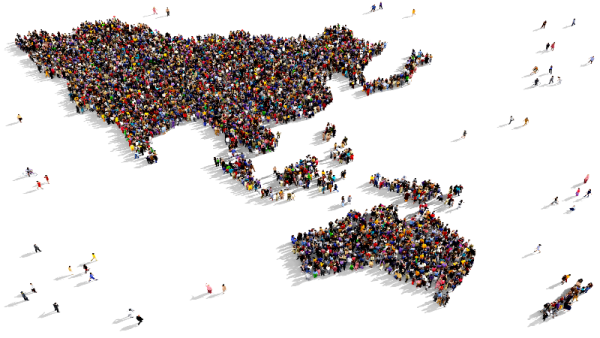Arthimedes / Shutterstock

Elena Collinson, Senior Project and Research Officer, Australia-China Relations Institute, University of Technology Sydney |

James Laurenceson, Director, Australia-China Relations Institute, University of Technology Sydney |
Australia’s travel ban on foreign nationals originating from, or transiting through, the People’s Republic of China (PRC) is now in its fifth week. While other countries, such as India, Singapore, and the Philippines, among others, have similar restrictions in place, Australia, along with the US, have seemingly been on the receiving end of some of the stronger public protests from PRC diplomatic representatives. Following the extension of the ban, the embassy released a statement expressing ‘deep regret and dissatisfaction’ at the move, describing it as an ‘overreaction’, and PRC Ambassador Cheng Jingye labelled the restrictions ‘harsh’.
These reactions seem to be reflective of the broader tensions in the relationship, with opportunities for public rebuke of Australia taken by the PRC now more frequently than not. For example, criticism of Australia’s decision to ban Huawei from participation in its 5G network has been reenergised by the UK’s decision to allow the company to participate in ‘non-core’ sections of its system (discussed in the February monthly wrap-up). PRC Ambassador Cheng on February 18 described Australia’s decision as ‘politically motivated’ and ‘discrimination against a Chinese company’ – forceful phrases in diplomacy. Prime Minister Scott Morrison declined to comment on the characterisation beyond saying, ‘I don’t share his view’.
Further inflaming the rift between Australia and the PRC on this front is the enthusiastic public campaign being waged by members of the Australian Parliament’s intelligence committee against the UK’s decision, with its deputy chair, Labor backbench MP Anthony Byrne, making the unusual decision to reprimand UK Foreign Secretary Dominic Raab during a meeting. In comments leaked to the press he reportedly said, ‘How would you feel if the Russians laid down infrastructure in your own networks? That’s how we feel about Huawei’.
The US is continuing with its efforts to exert pressure on Australia with respect to its position on the PRC, encouraging the country to take a stronger stance – one ostensibly more in line with the American view on the PRC as a strategic competitor. The commander of the US Armed Forces in the Indo-Pacific, Admiral Philip Davidson, used a recent visit to press the point that the PRC was the ‘strategic and defining challenge of the century’, emphasising ‘its very pernicious approach to the region in all aspects’. He listed as supporting examples the PRC’s ‘excessive territorial claims, debt trap diplomacy, violations of international agreements, theft of international property, military intimidation and outright corruption’. He also emphasised Beijing’s ‘willingness to intervene in free markets and to hurt Australian companies simply because the Australian government has exercised its sovereign right to protect its national security’.
While senior Australian government ministers have made concerted efforts not to follow the US lead in the arena of tough rhetoric, the government has also made it plain it is alive to the challenges that the PRC poses in the region. Prime Minister Morrison on February 21 announced a $1.1 billion upgrade to RAAF Base Tindal in the Northern Territory, an investment that ‘will be integral to our alliance with the United States, and increase the reach of Air Force capabilities in the Indo-Pacific’.
The issue of foreign espionage and interference and how to best address it remains front and centre in Canberra, with more powers to counter foreign interference being considered. On February 24 Australian Security Intelligence Organisation Director-General Mike Burgess in his annual threat assessment stated, ‘The level of threat we face from foreign espionage and interference activities is…higher now, than it was at the height of the Cold War’. Prime Minister Morrison, in deliberately keeping to a different tack than that adopted by his predecessor, was reticent when asked to confirm whether ‘the biggest threat in terms of espionage and foreign interference coming from the [PRC]’ at a press conference. Backbench MP Andrew Hastie was quick to assert, however, that it was ‘very obvious’ the actor responsible for the increase in espionage and interference activities was the PRC. Home Affairs Minister Peter Dutton effectively confirmed the PRC’s involvement, but also noted that foreign agents were ‘not just from China, they’re from Iran and Russia and elsewhere.’
The PRC’s more forward-leaning posture in the world of diplomacy was highlighted this month by the participation of the PRC embassy in Australia’s deputy head of mission, Wang Xining, in the ABC TV panel discussion program Q+A. Subject to robust questioning, Mr Wang determinedly pushed party lines. Convincing an Australian audience did not seem to be the main aim.
On trade, the latest data update delivers a final shot of good news before the COVID-19 virus outbreak starts to impact the numbers. It also rounds out the full year 2019 results for goods exports and imports. Last year goods exports finished at $149.6 billion, up 27.0 percent from a year earlier. To be sure though, this result was driven entirely by the mining sector with exports of non-mining goods stagnant. Of course, within the broad heading of non-mining goods there were notable exceptions such as food and beverages, which continued to perform strongly. But combined with flat-lining services exports, the result is more precarious than the aggregate numbers might suggest. Still, the fact that two-way trade last year reached $250.9 billion is an extraordinary outcome.
On the COVID-19 outbreak, there is evidence that production in the PRC is starting to return to something like normal levels. Data covering congestion, public transport usage and night lights in industrial parks are all pointing in this direction. The implications for Australia are that supply chain issues will start to be relieved but the drag on the demand side will linger. In particular, while factory production lines might bounce back relatively quickly, parts of the PRC’s services sector, like the restaurant trade, will be slower to recover, with knock-on effects for Australian exports such as food and beverages. It might be expected the Australian government will ease travel restrictions on mainland Chinese students and tourists relatively soon – they seem to be making moves in that direction, at least. As the virus spread slows in the PRC but accelerates in other parts of the world, maintaining country-specific restrictions would appear to no longer make public health sense, while also incurring a real economic cost. [1]
Key trade indicators table - February 2020
Sources
[1] Muyu Xu, Gavin Maguire, 'More traffic, night lights show China's factories restart as new virus cases drop', Reuters, March 2 2020 <https://www.
reuters.com/article/us-health-coronavirus-china-bigdata/more-traffic-night-lights-show-chinas-factories-restart-as-new-virus-cases-dropidUSKBN20P1GE>.
Authors
Elena Collinson, Senior Project and Research Officer, Australia-China Relations Institute, University of Technology Sydney
Professor James Laurenceson, Director, Australia-China Relations Institute, University of Technology Sydney


